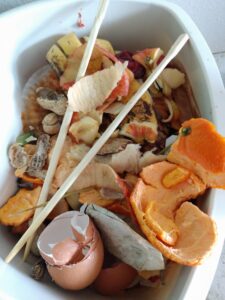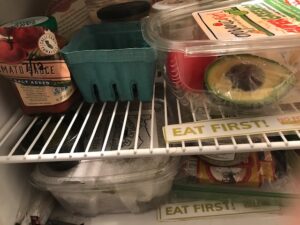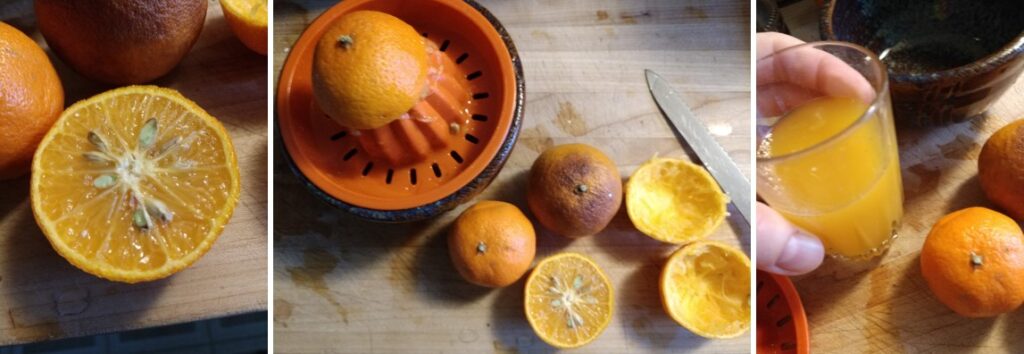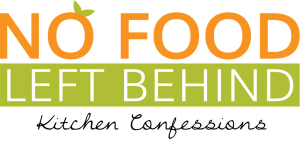Greetings, Conscientious Food Consumers!
We’ve all come a long way since the start of Kitchen Confessions, haven’t we? Doing the best we can to keep on living, working, virtual learning, shopping, cooking and eating our way through a pandemic. Getting real about wasted food in our homes, and doing what it takes to get the most out of our grocery dollars — each and every month. It’s time for some congratulations, all around!
We’re going to share some modest triumphs — ours and a few of yours — in the daily struggle against shriveled, moldy and slimy produce, leftovers that turned into science experiments, freezer-burned whatever, and many other tragedies involving formerly-edible food. These anecdotes illustrate positive outcomes from increased awareness of our daily food habits.
Remember also to pat yourselves on the back, Conscientious Food Consumers, for helping to conserve all those precious natural and human resources — energy, soil, water, labor, packaging, transportation and delivery systems — that went into your food. And locally, you’re helping to meet the goals of the in the Corvallis Climate Action Plan, in which reduction of wasted food is a high priority (p.17).
We like how Mishele M. of Corvallis puts it:
“It’s a mindset, that it’s unconscionable to throw anything away. That food gave its life for us, so why would we throw it away?! We don’t take our resources lightly.” Here’s more about why prevention of wasted food matters.
CONFESSIONS CONVERTED/LESSONS LEARNED: NFLB staff

JEANETTE: It’s a happy day in my household when I prepare to empty the contents of my compost pail and see ONLY non-edible food scraps, peels, and trimmings. I feel like, yay! We’re getting it right!

KAREN: Thanks to Kitchen Confessions, I’ve had to keep up with reality-checking in my own kitchen and being candid about it all… Especially after using our DIY Wasted Food Discovery worksheet, and I realized I was potentially wasting as much as $1,000 a year!
So I set a goal of saving at least $5 per week through better leftovers management in my Eat First! areas, and converted a couple of clear plastic salad containers into see-through Eat First! bins. They keep the items in one place, instead of migrating all over in the fridge! One for greens (layered with damp paper towels) and one for wrapped fruit/veggie, cheese or protein remnants. For at least one meal each day, I rummage in there and head for the blender, skillet or sheet pan.
LESSON LEARNED: It’s easy to save $5/week by making one meal each day using items from Eat First! It’s also easier now to stay on top of my “alligator pears”!
JEANETTE: Best.Glass.Of.Juice.Ever.
A few forgotten mandarin oranges in the bottom of our fridge drawer were discolored and shriveling. I hoped there was still some way to enjoy them, NOT just waste them in compost. So I cut one open and voila! Inside there was still plenty of moisture and good color. I remembered I had a plastic hand juicer tool in the cupboard and went to town. Result: a glass of deliciousness! 
CONFESSIONS CONVERTED/LESSONS LEARNED: Community members
- No milk or corncob scraps left behind (Stasi K of Corvallis)
When milk doesn’t smell or taste perfect anymore but is still “ok” to consume (a bit sour but not curdling), I use it right away in place of buttermilk in pancakes or I’ll freeze it to cook with (heating it provides additional safety).
We also take boiled corn on the cob, slice off and eat the corn, then take the remaining cob/husks and simmer them in the same water for half an hour to make corn stock for a nice flavor addition (can be used like veggie stock). Just strain off the solids.
FOOD SAFETY NOTE: for dairy and other safe food storage info, search StillTasty.com or FoodKeeper, a comprehensive resource from the USDA. It’s one of several handy tools on NFLB’s Apps page.
- Friendly fridge reminders (Mishele M of Corvallis)
 My spouse and I grew up with Depression-era parents, so in both our families the culture is to never, ever throw anything out unless it’s truly inedible. If something DOES start to get old, we just cook it instead of eating it raw.
My spouse and I grew up with Depression-era parents, so in both our families the culture is to never, ever throw anything out unless it’s truly inedible. If something DOES start to get old, we just cook it instead of eating it raw.
I’ve trained my hubby not to take items out of the freezer for a meal if something else is already waiting to be eaten up in the fridge. We’ve also found that keeping things well-labeled and to the front of the fridge shelves helps us know which items to attend to next!
When root veggies go soft, we crisp them back up in cold water. That works well for greens too, like Swiss chard and beet greens. We just place them upright in a glass in the fridge or on windowsill.
NOTE: Here’s more helpful tips on freshening up veggies and other compost-rescue strategies.
- No cukes or zukes left behind (Susan S of Corvallis)
We used to store our purchased cucumbers in plastic bags, and weren’t eating them up fast enough. Then we learned from NFLB’s A-Z Fruit & Veggie Storage Guide how to properly store them loosely in the crisper drawer. Now our cukes last longer and don’t get slimy, maybe a bit limp or dehydrated, so we slice and crisp them up in cold water.
With zucchinis: we like to shred them and mix with salt, which pulls out the moisture, then grab fistfuls and squeeze out as much of the juice as possible. From there it can be substituted in place of potato in latkes/pancakes, or as a base layer for homemade pizza. The zuke gets soft and it makes the pizza super moist!
- Cider now, cider later (Pat W of Corvallis)
One reader responded to our apple blog last year with this no-waste tip: I always split jugs of fresh cider and put (half) in the freezer for another time.
 *****
*****
Got a Confession/Lesson Learned to Share? We’d love to hear your anecdotes about how you’re able to waste less food! Let us know by commenting below. You can also submit via our contact page: https://nofoodleftbehindcorvallis.org/contact/.



 Kids rocking the waste-less kitchen
Kids rocking the waste-less kitchen
I made a yeast bread using a smoothie mix the grandkids didn’t like – I had used peaches, a banana, an apple and a plum with a small amount of apple juice. For the bread, I used just a white bread recipe and subbed the fruit slurry in for milk. It was delicious. I made 4 loaves and was able to share with the neighbors.
Thank you, Amy – what a great way to salvage that smoothie and share with others!
We enjoyed meeting you at the Downtown Corvallis Farmers’ Market last weekend. 🙂
Here are 3 pickle recipes that do not require regular canning methods. Just make them, put a lid on (doesn’t even have to seal!) and store them in your refrigerator or on your pantry shelf, as directed by the recipe. These are recipes that came from my mom and her friends. I have used them over and over with great success! The first is for dill pickles. Check out the next 2 comments for 2 different sweet pickle recipes.
Dill Pickles a Jar at a Time
For each quart you will need:
½ cup white vinegar
2 Tbsp sea salt
1 tsp mixed pickling spices
1 large head dill
1 clove garlic
¼ tsp alum
Place dill in a clean quart jar; pack cucumbers into jar (whole or speared). Add remaining ingredients and fill jar with cold water. Put a lid on the jar – it does not have to be sealed. Shake slightly. Place jar on pantry shelf. Ready to use in 2-3 months.
Here is the 2nd of the easy pickle recipes – appropriately called Easy Sweets!
Easy Sweets
Wash and fill a quart jar with small cucumbers. Add:
1 cup white vinegar
2 ¼ tsp mixed pickling spices
1 ½ tsp prepared horseradish
1 Tbsp sea salt
½ tsp alum
Finish filling jar with cold water. Put a lid on (does not have to seal), shake well, place on pantry shelf and shake every week or so.
3-4 months later, drain jars and wash cucumbers in cold water. Slice cucumbers in half, lengthwise and place in a clean quart jar. To each quart add 1 slight cup sugar. Put lids on (again they do not have to seal) and shake well. Let stand 24 hours. After that, shake occasionally, every week or so. Ready to use after 2-3 weeks.
And the last one is Refrigerator Sweet Pickles. I think of these more as sweet and sour, but that’s not what my mom’s friend, Lena, called them, so I stick with her name for them.
Refrigerator Sweet Pickles
1 gallon sliced cucumbers (measure after slicing)
1-2 onions, sliced
Pack tightly into jars. They do not have to be canning jars – they will not have to be sealed, just lidded.
Stir together and boil:
4 cups sugar
½ cup sea salt
1 1/3 tsp celery seed
1 1/3 tsp turmeric
1 1/3 tsp yellow mustard seed
4 cups white vinegar
Pour over cucumbers and onions. Place lid on jar and store in refrigerator. Ready to use in 2 months.
Thanks for these pickle recipes, Donna! I’m helping out in a friend’s garden and we’re up to our ankles in cukes right now…
Hey everybody — did you know you can also make pickles from watermelon rinds?
See Donna’s recipe which we featured in Kitchen Confessions this past spring! https://nofoodleftbehindcorvallis.org/watermelon-rind-pickles/